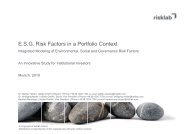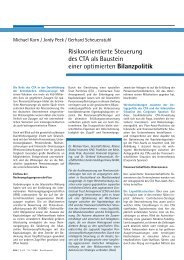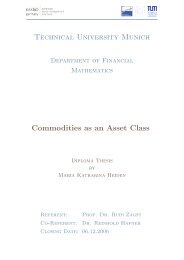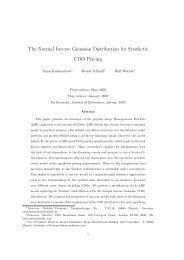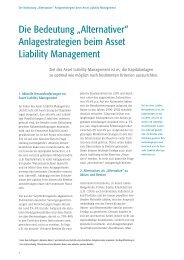Technische Universität München Credit as an Asset Class - risklab
Technische Universität München Credit as an Asset Class - risklab
Technische Universität München Credit as an Asset Class - risklab
Create successful ePaper yourself
Turn your PDF publications into a flip-book with our unique Google optimized e-Paper software.
CHAPTER 2. CREDIT RISK TRANSFER<br />
Within the recent years, a shift in credit quality of the reference entities h<strong>as</strong> taken<br />
place. While in 2002 the share of AAA-rated reference entities w<strong>as</strong> 22%, it decre<strong>as</strong>ed to<br />
14% in 2004. A similar reduction on a relative b<strong>as</strong>is c<strong>an</strong> be observed for AA- <strong>an</strong>d A-rated<br />
reference entities. In contr<strong>as</strong>t, the share of BBB-rated reference entities incre<strong>as</strong>ed from<br />
28% in 2002 to 32% in 2004. The share of below investment-grade rated reference entities<br />
incre<strong>as</strong>ed from 8% in 2002 to 24% in 2004. These developments have various re<strong>as</strong>ons:<br />
Partly, the shift in the high-rated reference entities c<strong>an</strong> be explained by a negative ratings<br />
migration. But there is also a ch<strong>an</strong>ge in investors’ needs <strong>an</strong>d in the structure of the market<br />
particip<strong>an</strong>ts. There is a growing dem<strong>an</strong>d for high-yield CDS indices <strong>an</strong>d index products,<br />
which is driven to a large extent by hedge funds. They are looking for <strong>an</strong> alternative way<br />
to trade credit risk, with a focussed interest in high-yield <strong>as</strong>sets. 60<br />
St<strong>an</strong>dardisation of Documentation<br />
<strong>Credit</strong> derivatives are legally binding contracts between two counterparties, which may<br />
involve legal risk 61 <strong>an</strong>d enormous tr<strong>an</strong>saction costs (including setup, negotiation <strong>an</strong>d ad-<br />
ministration costs), if every contract is negotiated individually. The counterparties have<br />
to agree upon key items, such <strong>as</strong> maturity, premium, reference entity, credit event, etc.. 62<br />
In order to st<strong>an</strong>dardise the contracts <strong>an</strong>d to facilitate trading, the International Swaps<br />
<strong>an</strong>d Derivatives Association (ISDA) 63 h<strong>as</strong> pursued a steady convergence of documentation<br />
st<strong>an</strong>dards for b<strong>as</strong>ic credit derivatives contracts. In 1997, ISDA published the first set of<br />
credit derivatives documents. In 1999, the <strong>as</strong>sociation issued the ”M<strong>as</strong>ter Agreement”<br />
<strong>an</strong>d the ”<strong>Credit</strong> Derivatives Definitions”, of which a new version w<strong>as</strong> published in 2003.<br />
The former is a contract of general nature between the two counterparties on which is<br />
agreed upon before the first credit derivative contract is signed. It contains legal <strong>as</strong>pects,<br />
procedures in c<strong>as</strong>e of default of one counterparty, etc.. The latter defines key terms, such<br />
<strong>as</strong> possible credit events or possible settlement procedures. ISDA in cooperation with<br />
its members h<strong>as</strong> continuously improved these publications in order to meet the ch<strong>an</strong>ging<br />
needs of market particip<strong>an</strong>ts. 64<br />
The ISDA st<strong>an</strong>dard contract specifies all obligations <strong>an</strong>d rights of the counterparties<br />
<strong>as</strong> well <strong>as</strong> key definitions, such <strong>as</strong> reference entity, credit event <strong>an</strong>d its verification, etc. It<br />
contains some fixed core terms <strong>an</strong>d definitions, some clauses, however, are variable.<br />
Several events c<strong>an</strong> be included in the definition of a credit event, for example b<strong>an</strong>k-<br />
ruptcy, obligation acceleration, failure to pay, moratorium, restructuring. 65<br />
<strong>Credit</strong> derivatives c<strong>an</strong> be settled either physically or c<strong>as</strong>h. Physical settlement me<strong>an</strong>s<br />
that in c<strong>as</strong>e of default, the protection buyer h<strong>as</strong> to deliver the designated obligation to the<br />
protection seller in return for the par value of the reference obligation. C<strong>as</strong>h settlement<br />
me<strong>an</strong>s that if a credit event occurs, the protection seller h<strong>as</strong> to pay the difference between<br />
the par value <strong>an</strong>d the market value or the recovery value of the reference obligation to the<br />
protection buyer in c<strong>as</strong>h.<br />
60<br />
See [Fit05], p. 7, 10.<br />
61<br />
The legal risk involved in credit derivatives contracts is described in Section 2.3.4.<br />
62<br />
See [Bom05], p. 26, [Cha05], p. 57.<br />
63<br />
ISDA is <strong>an</strong> <strong>as</strong>sociation composed of leading swap <strong>an</strong>d derivatives market particip<strong>an</strong>ts.<br />
64<br />
See [Bom05], p. 26, 286, [BR04], p. 17.<br />
65<br />
For a description of the events, we refer for example to [D<strong>as</strong>06], pp. 712-717 or to [Bom05], pp.<br />
289-290.<br />
23



